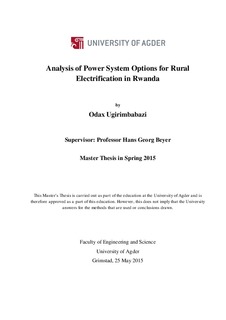| dc.description.abstract | The development of modernized energy system for developing countries especially in rural areas is
constantly a considerable problem to energy utilities. The progressive use of diesel generators in
rural areas as main source of electrification is continuously becoming unsuitable because of the
following reasons; the diesel generator requires the fuel at every single second of operation and
the maintenance of every time is needed and it is very important to worry about the instability of
power generated by those generators and the accessibility of fossil fuels is still a challenge for some
communities. Whereas the introduction of new technologies by using Renewable Energy systems
RESs has given a hope, confidence and security in electrification of rural communities. With a
combination of RETs, a traditional diesel generation and batteries, a mini power system of the
combination is adequate to manage harmony in operation, therefore granting a stable means of
developing electrical power system to the developing countries especially those ones in rural areas.
The target of this development is the analysis of a mini hybrid power system options to come up with the
best techno-economic and optimum configuration of RETs for supplying electricity to one village in
Rwanda. In this development, a hybrid system with a low cost of energy is presented for
electrification of one of isolated village of Burera district, in Northern Province of Rwanda. First
of all, the renewable resources are determined, an assessment of the predicted village energy
demand is estimated, and using the software called HOMER, a best hybrid system types is
described, elements measured, and the optimization of the system configuration is done to come up
with the reliable and efficient operation in order to answer to the village demand with an
economical cost.
The system type is discovered as follows; a micro hydropower plant, diesel generator and a
compound of batteries and this is found as the best option. In detail, for the case studied the best
hybrid system has the following configuration: a micro hydro power plant (MHPP) of 20 kW, the
diesel generator of 10 kW and the battery bank of 55.5 kWh. The MHPP generates 99.6 % of the
total output, which is approximately 198,000 kWh/yr. The diesel generator is used to supply only
0.4 % of the total generation, resulting in 207 hours of operation annually. The obtained system
configuration has a rough cost of energy of 0.2 $/kWh and may be further reduced to 0.13 $/kWh,
if state subsidies become available for covering 40 – 50 % of the capital investment. It clear that
this hybrid system is more economically viable whether it is operated as off-grid or grid connected. | nb_NO |
